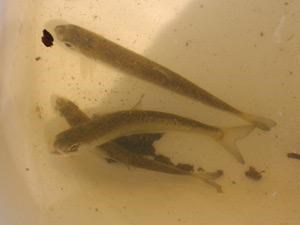A creek restoration project to return a sea-run cutthroat trout fishery on Lasqueti Island has the federal government paying attention.
At the south end of Lasqueti, Wamer Creek winds its way through three properties a quarter section each, and the Squitty Bay Park. Island residents have undertaken to restore what were once vibrant fish populations in the island’s creeks as part of a larger plan to restore the island to a heritage state. The work the islanders have done has netted them an award from Department of Fisheries and Oceans Canada (DFO).
Lasqueti is the least developed island in the southern BC archipelago. Powered by solar, micro-hydro, fossil-fueled generators and wind power, it is off the grid.
There have been thousands of trees planted, streams with rejuvenated fish stocks, and a heritage garden, all to invigorate and preserve the wilderness and the landscape.
Island resident Wayne Bright was inspired by a book in his family’s collection. The novel Poor Man’s Rock, by author Bertrand Sinclair, was set partially on Lasqueti. “He was a British pilot and he came out here after the war,” said Bright. “In the book he indicated that he owned this property at the south end of Lasqueti. He would walk up the road parallel to the creek to see what was hatching and tie flies to match the entomology at the time.”
Part of the restoration of the island to a heritage state involved the acquisition of Squitty Bay Park, purchased by a group of islanders and donated as parkland. The area is currently undergoing a process Bright calls re-wilding: returning the land to its heritage state.
“We’ve been restoring the salmon in the creek—coho and chum salmon—but I couldn’t get the cutthroat to come back,” he said. “Then we realized that the salmon need to be there in order for the cutthroat to flourish. In a sense, I had to set the table in order to entice the cutthroat to come into the stream. I’m trying to develop my own fishery here because I don’t think the government is going to take care of it. We got an award from the DFO in recognition of the stream restoration work being done on the island.”
Bright explained that if the salmon and cutthroat come back it would kick-start the bio-process again.
Right beside Bright’s location is virgin old growth forest. Some of the trees are 25 feet around. Bright managed to identify the age of one of the trees at 1,500 years old.
“In Greece the only trees left are on the flag,” said Bright. “Around 85 per cent of the nutrients are tied up in the trees. If you take the trees away you’re essentially denuding the forest. You are actually mining nutrients. In Mexico, when the Conquistadors came through, they stripped the forests at Mount Alba. Now the entire area is all cactus.”
Bright said as part of his 200-year plan to create sustainable resource and restore the island’s original state, he is also producing trees to provide for specialty woods—wood to make guitar tops, for instance. Greg Keiler from Prairie Oyster played one of the guitars made from the island’s wood.
A heritage grower registered with the ministry of agriculture, Bright said there are 65 types of apples on the island. Also, “there are big radishes that look like Chinese radishes but they grow about a metre long,” he said. “There are two rows of malting barley for making beer, there’s Himalayan purple barley, Ethiopian black barley (presents a really nice nutty flavour), there is camellia (an oil crop from Russia).” There are oil sunflowers which provide oil for his tractor, there is golden flax, there are lentils and speckled peas. There are 10 kinds of beans, and there’s sorghum. There are radishes, flax, wheat from a cross between marquis and reward wheat, developed in 1862 in Ontario. There is gamut, there are 21 kinds of pears, there are plums, persimmons and pawpaw trees. According to Bright, people who went on a CN Rail train during the 1950s could experience pawpaw custard. It was the signature dish.
Of his thinking around why he is intent on restoring the land, Bright said, “People don’t have sense of their history, of where they came from and where they’d like to go. Chief Seattle said there is a seven-generation cycle: you have to look seven generations back and seven forward and let that be your guide.”



